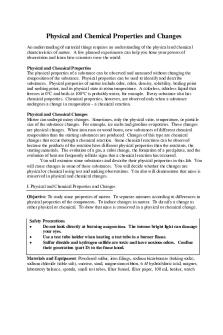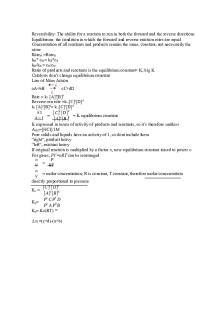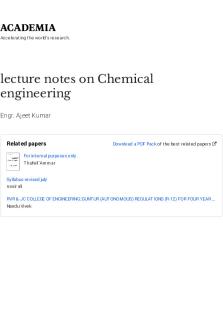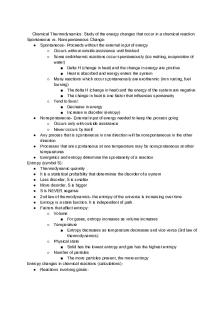Bitesize Notes - Chemical Changes PDF

| Title | Bitesize Notes - Chemical Changes |
|---|---|
| Author | Nelson Wong |
| Course | Chemistry |
| Institution | University of Reading |
| Pages | 57 |
| File Size | 1.9 MB |
| File Type | |
| Total Downloads | 19 |
| Total Views | 147 |
Summary
Bitesize Notes - Chemical ChangesBitesize Notes - Chemical ChangesBitesize Notes - Chemical ChangesBitesize Notes - Chemical ChangesBitesize Notes - Chemical ChangesBitesize Notes - Chemical Changes...
Description
The Alkali Metals and the Reactivity Series The Group 1 elements are called the alkali metals. They are placed in the vertical column on the left-hand side of the periodic table. They include lithium, sodium and potassium, which all react vigorously with water to produce an alkaline solution (pH >7).
Reactions of alkali metals with water All the alkali metals react vigorously with cold water. In each reaction, hydrogen gas is given off and the metal hydroxide is produced. The speed and violence of the reaction increases as you go down the group. This shows that the reactivity of the alkali metals increases as you go down Group 1.
Lithium When lithium is added to water, lithium floats. It fizzes steadily and becomes smaller, until it eventually disappears. What happens to the Lithium?
lithium + water → lithium hydroxide + hydrogen (Word equation)
2Li(s) + 2H2O(l) → 2LiOH(aq) + H2(g) (Symbol Equation – what do (s), (l), (aq) and (g) indicate?)
Sodium When sodium is added to water, the sodium melts to form a ball that moves around on the surface. It fizzes rapidly, and the hydrogen produced may burn with an orange flame before the sodium disappears. 1
sodium + water → sodium hydroxide + hydrogen
2Na(s) + 2H2O(l) → 2NaOH(aq) + H2(g)
Potassium When potassium is added to water, the metal melts and floats. It moves around very quickly on the surface of the water. The hydrogen ignites instantly. The metal is also set on fire, with sparks and a lilac flame. There is sometimes a small explosion at the end of the reaction.
potassium + water → potassium hydroxide + hydrogen
2K(s) + 2H2O(l) → 2KOH(aq) + H2(g)
Strong alkalis The hydroxides formed in all of these reactions dissolve in water to form alkaline solutions. These solutions turn universal indicator purple, showing they are strongly alkaline. Strong alkalis are corrosive. Care must be taken when they are used - goggles and gloves must be worn.
Explaining reactivity The Group 1 elements have similar properties because of the electronic structure of their atoms - they all have one electron in their outer shell.
2
Explaining trends
In a reaction, an atom of a Group 1 element will form an ion with a single positive charge. For example, for sodium forming a sodium ion – Q: what is an ion? Na → Na+ + e– A change like this, where an electron is lost, is an example of oxidation. The ions formed have a stable electronic structure, like a noble gas from Group 0. The reactivity of Group 1 elements increases as you go down the group because:
the atoms get larger as you go down the group
the outer electron gets further from the nucleus as you go down the group
the attraction between the nucleus and outer electron gets weaker as you go down the group - so the electron is more easily lost
The alkali metals - Test Questions 1 What name is given to the elements in Group 1? The alkali metals The halogens The noble gases 3
2 Why must the elements in Group 1 be stored under oil? They are poisonous They are very valuable They react quickly with oxygen in the air
3 What is produced when sodium reacts with water? Sodium oxide Sodium hydroxide and hydrogen Sodium chloride
4 What would you expect to see when a piece of potassium is placed into a large bowl of water? Floats, fizzes, moves around quickly, sparks Sinks, no reaction Floats, moves around slowly
5 How can you tell that the solution left after a Group 1 element has reacted with water is alkaline? Turns limewater cloudy Turns universal indicator purple Turns methyl orange red
6 Which half equation shows the process of a potassium atom losing an electron? K → K2+ + 2eK+ + e - → K 4
K → K+ + e-
7 Why is sodium more reactive than lithium? The outer electron is closer to the nucleus, so it is lost more easily The outer electron is further from the nucleus, so it is harder to lose The outer electron is further from the nucleus, so it is lost more easily
1 What name is given to the elements in Group 1? You said: The alkali metals The elements in Group 1 are called the alkali metals because they react with water to produce an alkaline solution.
2 Why must the elements in Group 1 be stored under oil? You said: They react quickly with oxygen in the air The alkali metals will react quickly with the oxygen in air, so storing them under oil prevents this from happening.
3 What is produced when sodium reacts with water? You said: Sodium hydroxide and hydrogen Sodium hydroxide and hydrogen are produced when sodium reacts with water. The sodium hydroxide is a strong alkali.
4 What would you expect to see when a piece of potassium is placed into a large bowl of water? You said: Floats, fizzes, moves around quickly, sparks Potassium is very reactive, but less dense than water, so it floats and reacts quickly.
5
5 How can you tell that the solution left after a Group 1 element has reacted with water is alkaline? You said: Turns universal indicator purple Universal indicator turns purple in the presence of a strong alkali.
6 Which half equation shows the process of a potassium atom losing an electron? You said: K → K+ + eEach potassium atom loses one electron to become stable, so the electron and positive potassium ion are shown on the right side of the equation.
7 Why is sodium more reactive than lithium? You said: The outer electron is further from the nucleus, so it is lost more easily Metals react by losing electrons, and the further from the nucleus, the more easily it is lost. Sodium is bigger than lithium, so it loses its outer electron more easily.
HOW TO REMEMBER THE REACTIVITY SERIES
"Pond Slime Can Make A Zoo Interesting - The Long Crinkly Sort Goes Purple."
6
Reactions of metals The reactivity series shows metals in order of reactivity. The reactivity of a metal is related to its tendency to form positive ions. Iron and aluminium are extracted from their ores in various ways.
The reactivity series of metals When metals react with other substances, the metal atoms lose electrons to form positive ions. The reactivity series of metals is a chart showing metals in order of decreasing reactivity. In general, the more reactive a metal is:
the more vigorous its reactions are
the more easily it loses electrons in reactions to form positive ions (cations) The table summarises some reactions of metals in the reactivity series. Hydrogen and carbon are shown for comparison.
Reactions of metals with water When a metal reacts with water, a metal hydroxide and hydrogen are formed. For example, sodium reacts rapidly with cold water: Sodium + water → sodium hydroxide + hydrogen 2Na(s) + 2H2O(l) → 2NaOH(aq) + H2(g) In general, the more reactive the metal, the more rapid the reaction is.
7
Question Describe and explain the observations when a small piece of lithium is placed on the surface of a big container of water. A few drops of universal indicator have been added to the water. There is fizzing as the lithium reacts with the water to produce hydrogen gas. The colour of the universal indicator changes from green to purple as an alkaline solution of lithium hydroxide is produced.
Reactions of metals with dilute acids When a metal reacts with a dilute acid, a salt and hydrogen are formed. For example, magnesium reacts rapidly with dilute hydrochloric acid: Magnesium + hydrochloric acid → magnesium chloride + hydrogen Mg(s) + 2HCl(aq) → MgCl2(aq) + H2(g) The more reactive the metal, the more rapid the reaction is. A metal below hydrogen in the reactivity series will not react with dilute acids. Question Platinum is placed below gold in the reactivity series. Predict its reaction with dilute acids and explain your answer. Platinum will not react with dilute acids. Metals below hydrogen in the reactivity series do not react with dilute acids, and both gold and platinum are placed below hydrogen.
Hydrogen is always made when a metal reacts with water or a dilute acid.
8
Oxidation, reduction and displacement reactions Reactions of metals with oxygen Many metals react with oxygen to make metal oxides. For example, magnesium burns rapidly in air: Magnesium + oyxgen → magnesium oxide 2Mg(s) + O2(g) → 2MgO(s) The reactions are oxidation reactions because the metal gains oxygen. Oxygen can be removed from metal oxides in chemical reactions. For example: Copper oxide + carbon → copper + carbon dioxide 2CuO(s) + C(s) → 2Cu(l) + CO2(g) In this reaction, carbon is oxidised because it gains oxygen. At the same time, copper oxide is reduced because oxygen is removed from it. Oxidation is the gain of oxygen. Reduction is the loss of oxygen.
Displacement in solutions A more reactive metal can displace a less reactive metal from its compounds. For example, magnesium is more reactive than copper. It displaces copper from copper sulfate solution: Magnesium + copper sulfate → magnesium sulfate + copper Mg(s) + CuSO4(aq) → MgSO4(aq) + Cu(s) In this displacement reaction:
magnesium becomes coated with copper
the blue colour of the solution fades as blue copper sulfate solution is replaced by colourless magnesium sulfate solution
9
Deducing a reactivity series A reactivity series can be deduced by carrying out several displacement reactions. A piece of metal is dipped into a salt solution. Different combinations of metal and salt solution are tested. The table shows the results of one of these investigations. Magnesium sulfate solution Magnesium
Copper sulfate solution
Iron sulfate solution
Number of reactions
Not done
Brown coating
Black coating
2
Copper
No visible reaction
Not done
No visible reaction 0
Iron
No visible reaction
Brown coating
Not done
1
Question Use the results in the table to deduce an order of reactivity, starting with the most reactive metal. The order of reactivity is: magnesium > iron > copper. This is because magnesium displaced copper and iron, iron displaced copper only, but copper could not displace magnesium or iron. Question Explain why three combinations of metal and salt solution were not done in the investigation. A metal cannot displace itself from a solution of one of its salts. There would be no reaction, so these combinations were not done. 10
Displacement reactions as redox reactions - Higher tier A balanced equation for the reaction between magnesium and copper sulfate solution can be written in terms of the ions involved: Mg(s) + Cu2+(aq) + SO42-(aq) → Mg2+(aq) + SO42-(aq) + Cu(s) Sulfate ions, SO42-, appear on both sides of the equation, but they do not take part in the reaction. The equation can be rewritten without them: Mg(s) + Cu2+(aq) → Mg2+(aq) + Cu(s) This equation is an example of a balanced ionic equation. It can be split into two half equations : Mg(s) → Mg2+(aq) + 2e- (oxidation) Cu2+(aq) + 2e- → Cu(s) (reduction)
Notice that:
magnesium atoms lose electrons - they are oxidised
copper ions gain electrons - they are reduced Reduction and oxidation happen at the same time, so the reactions are called redox reactions. Oxidation is the loss of electrons, and reduction is the gain of electrons. It helps to remember OIL RIG - oxidation is loss of electrons, and reduction is gain of electrons. Displacement reactions are just one example of redox reactions. Electrolysis reactions are also redox reactions.
Extracting iron and copper Ores Unreactive metals such as gold are found in the Earth's crust as the uncombined elements. However, most metals are found combined with other elements to form compounds. Most metals are extracted from ore found in the Earth's crust. An ore is a rock that contains enough of a metal or a metal compound to make extracting the metal worthwhile.
Extraction methods The extraction method used depends upon the metal's position in the reactivity series. In principle, any metal could be extracted from its compounds using electrolysis. However, large amounts of electrical energy are needed to do this, so electrolysis is expensive.
11
If a metal is less reactive than carbon, it can be extracted from its compounds by heating with carbon. Copper is an example of this. Copper mostly occurs as sulfide ores, which are heated in air to convert them to copper(II) oxide. Molten copper can be produced from copper oxide by heating with carbon: Copper oxide + carbon → copper + carbon dioxide 2CuO(s) + C(s) → 2Cu(l) + CO2(g) Copper oxide is reduced as carbon is oxidised, so this is an example of a redox reaction. The table summarises the extraction methods used for different metals.
Although an unreactive metal is found as the metal itself, chemical reactions are often needed to remove other elements that might contaminate it.
Extracting iron Iron(III) oxide is reduced to molten iron when it reacts with carbon. One of the products is carbon monoxide: iron(III) oxide + carbon → iron + carbon monoxide Fe2O3(s) + 3C(s) → 2Fe(l) + 3CO(g) This method of extraction works because carbon is more reactive than iron, so it can displace iron from iron compounds. Extracting a metal by heating with carbon is cheaper than using electrolysis. Question In the reaction of iron(III) oxide with carbon, state which substance is reduced and which substance is oxidised. Carbon gains oxygen, so it is oxidised. Iron(III) oxide loses oxygen, so it is reduced
12
Extracting aluminium Aluminium is more reactive than carbon so it must be extracted from its compounds using electrolysis. Even though aluminium is more abundant than iron in the Earth's crust, aluminium is more expensive than iron. This is mainly because of the large amounts of electrical energy used in the extraction process.
Electrolysis of aluminium oxide The electrolyte Aluminium ore is treated to produce pure aluminium oxide. The electrolytes used in electrolysis are ionic compounds:
A cross section through an electrolysis cell Aluminium is in the molten state, or dissolved in water Aluminium oxide is insoluble in water, so it must be molten to act as an electrolyte. However, the melting point of aluminium oxide is high. A lot of energy must be transferred to break its strong ionic bonds, and this is expensive. To reduce costs, powdered aluminium oxide is dissolved in molten cryolite. This ionic compound melts at a lower temperature than aluminium oxide, reducing costs. However, significant amounts of energy are required to melt the cryolite.
The electrolysis process The diagram shows an electrolysis cell used to extract aluminium. Both electrodes are made of graphite, a form of carbon with a high melting point and which conducts electricity. During electrolysis:
at the cathode, aluminium ions gain electrons and form aluminium atoms
at the anode, oxide ions lose electrons and form oxygen gas The oxygen reacts with the carbon anodes, forming carbon dioxide. So the anodes are gradually oxidised. They must be replaced frequently, adding to the cost of producing aluminium.
13
Worked example - Higher Explain, with the help of a half equation, how oxide ions are oxidised during the electrolysis of aluminium oxide. The half equation is: 2O2- → O2 + 4e-. It shows that oxide ions lose electrons, and oxidation is loss of electrons. Question Explain, with the help of a half equation, how aluminium ions are reduced during the electrolysis of aluminium oxide. The half equation is: Al3+ + 3e- → Al It shows that aluminium ions gain electrons, and reduction is gain of electrons.
AQA Test questions 1 Which statement about the reactivity series is correct?
Metals at the bottom of the reactivity series lose electrons more easily than metals at the top of the series
Metals at the top of the reactivity series react less vigorously than metals at the bottom of the series
Metals at the top of the reactivity series lose electrons more easily than metals at the bottom of the series
2 What are the products of the reaction of sodium with water?
Sodium oxide and hydrogen
Sodium hydroxide and water
Sodium hydroxide and hydrogen
3 What are the products of the reaction of magnesium with sulfuric acid?
Magnesium sulfate and hydrogen
Magnesium sulfate and water
Magnesium chloride and water
14
4 Which substance is oxidised in the reaction represented by this equation? Lead oxide + carbon → lead + carbon dioxide
Lead oxide
Carbon
Lead
5 Which of these equations represents a displacement reaction?
Copper + oxygen → copper oxide
Zinc + copper sulfate → zinc sulfate + copper
Sodium + water → sodium hydroxide + water
6 The order of reactivity for three metals is magnesium, zinc, copper, where magnesium is the most reactive. Which of these equations represents a reaction that cannot occur?
Zinc + magnesium chloride → zinc chloride + magnesium
Zinc + copper chloride → zinc chloride + copper
Magnesium + copper chloride → magnesium chloride + copper
7 Which metal is found uncombined in the Earth's crust?
Gold
Zinc
Magnesium
15
8 Which element removes oxygen from iron(III) oxide in the industrial extraction of iron?
Copper
Calcium
Carbon
9 Which half equation represents the reaction that occurs at the anode in the extraction of aluminium by electrolysis? - Higher
Al3+ + 3e- → Al
2O2- → O2 + 4e-
C + O2 → CO2
10 Which substance is oxidised in the reaction represented by this ionic equation? - Higher Zn + Cu2+ → Zn2+ + Cu
Zn
Cu2+
Zn2+
1 Which statement about the reactivity series is correct? You said: Metals at the top of the reactivity series lose electrons more easily than metals at the bottom of the series Correct Metals at the top of the reactivity series lose electrons more easily than metals at the bottom of the series.
2 What are the products of the reaction of sodium with water? You said: Sodium hydroxide and hydrogen Correct The products of the reaction of sodium with water are sodium hydroxide and hydrogen.
16
3 What are the products of the reaction of magnesium with sulfuric acid? You said: Magnesium sulfate and hydrogen Correct The products of the reaction of magnesium and sulfuric acid are magnesium sulfate and hydrogen.
4 Which substance is oxidised in the reaction represented by this equation? Lead oxide + carbon → lead + carbon dioxide You said: Carbon Correct Carbon is oxidised in the reaction of lead oxide with carbon.
5 Which of these equations represents a displacement reaction? You said: Zinc + copper sulfate → zinc sulfate + copper Correct The reaction of zinc with copper sulfate to make zinc sulfate and copper is a displacement reaction.
6 The order of reactivity for three metals is magnesium, zinc, copper, where magnesium is the most reactive. Which of these equations represents a reaction that cannot occur? You said: Zinc + magnesium chloride → zinc chl...
Similar Free PDFs

Bitesize Notes - Chemical Changes
- 57 Pages

Physical and Chemical Changes
- 2 Pages

Exploring Chemical Physical Changes
- 10 Pages

Gizmo Chemical Changes SE
- 12 Pages

Chemical Changes Sehand IN COPY
- 13 Pages

Applying Chemical Ideas Study Notes
- 36 Pages
Popular Institutions
- Tinajero National High School - Annex
- Politeknik Caltex Riau
- Yokohama City University
- SGT University
- University of Al-Qadisiyah
- Divine Word College of Vigan
- Techniek College Rotterdam
- Universidade de Santiago
- Universiti Teknologi MARA Cawangan Johor Kampus Pasir Gudang
- Poltekkes Kemenkes Yogyakarta
- Baguio City National High School
- Colegio san marcos
- preparatoria uno
- Centro de Bachillerato Tecnológico Industrial y de Servicios No. 107
- Dalian Maritime University
- Quang Trung Secondary School
- Colegio Tecnológico en Informática
- Corporación Regional de Educación Superior
- Grupo CEDVA
- Dar Al Uloom University
- Centro de Estudios Preuniversitarios de la Universidad Nacional de Ingeniería
- 上智大学
- Aakash International School, Nuna Majara
- San Felipe Neri Catholic School
- Kang Chiao International School - New Taipei City
- Misamis Occidental National High School
- Institución Educativa Escuela Normal Juan Ladrilleros
- Kolehiyo ng Pantukan
- Batanes State College
- Instituto Continental
- Sekolah Menengah Kejuruan Kesehatan Kaltara (Tarakan)
- Colegio de La Inmaculada Concepcion - Cebu









